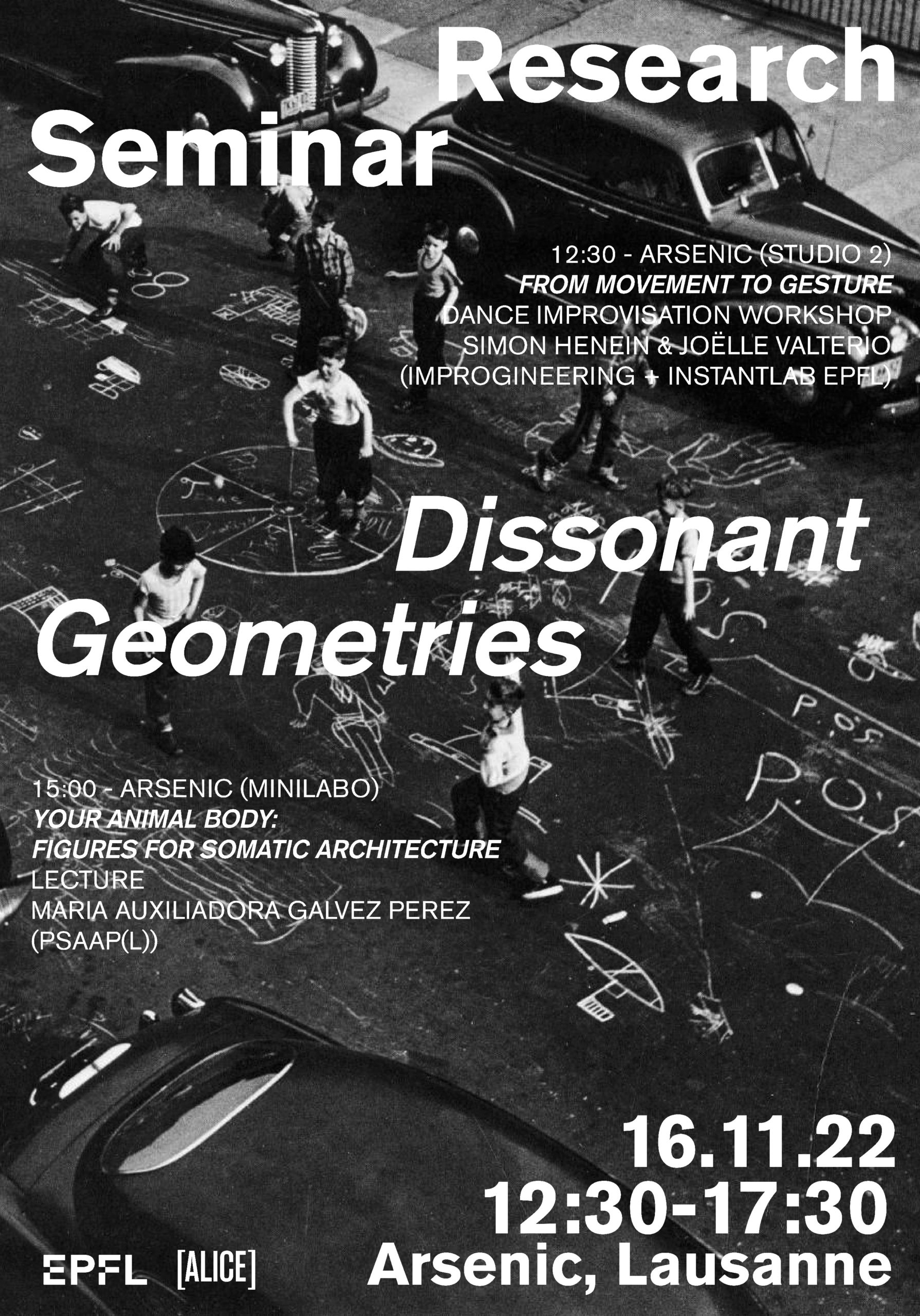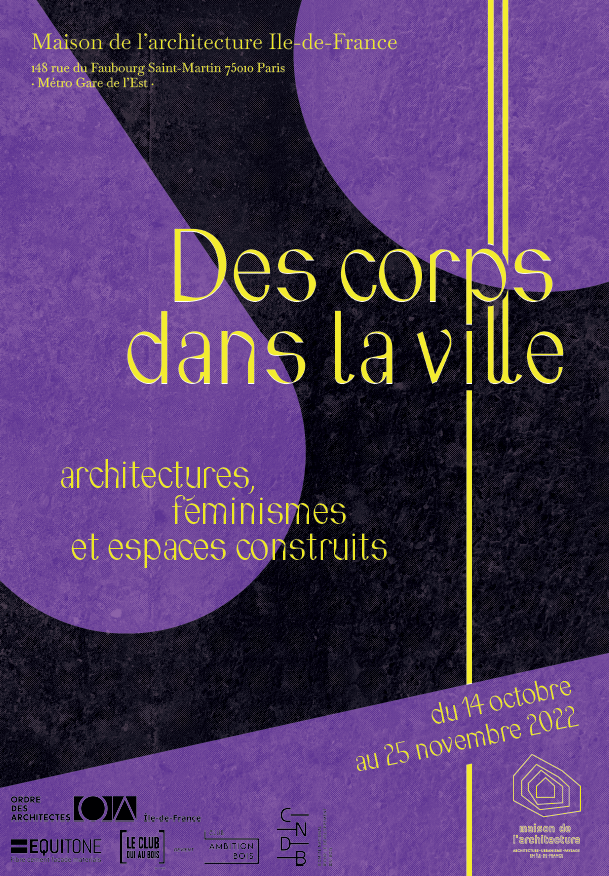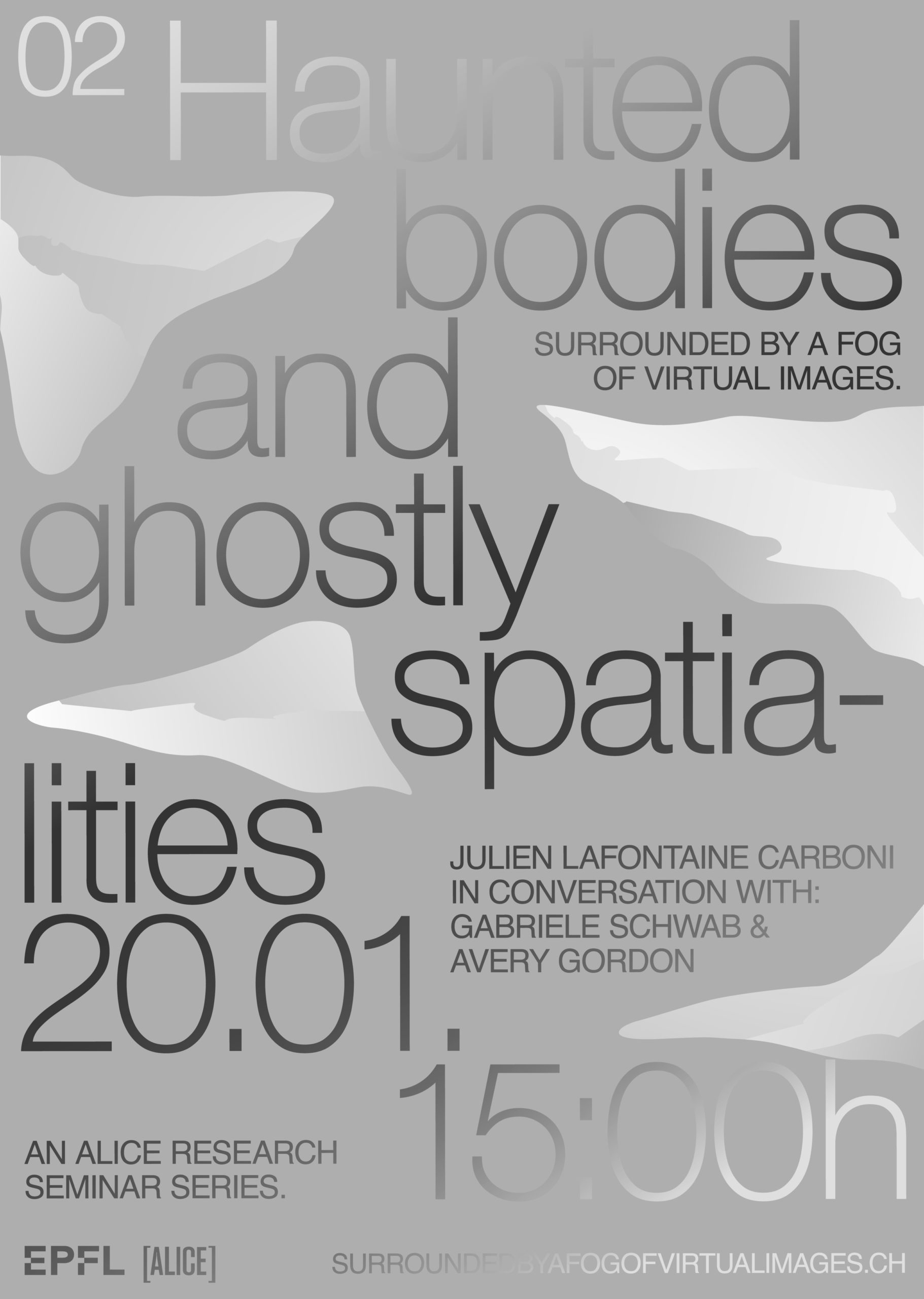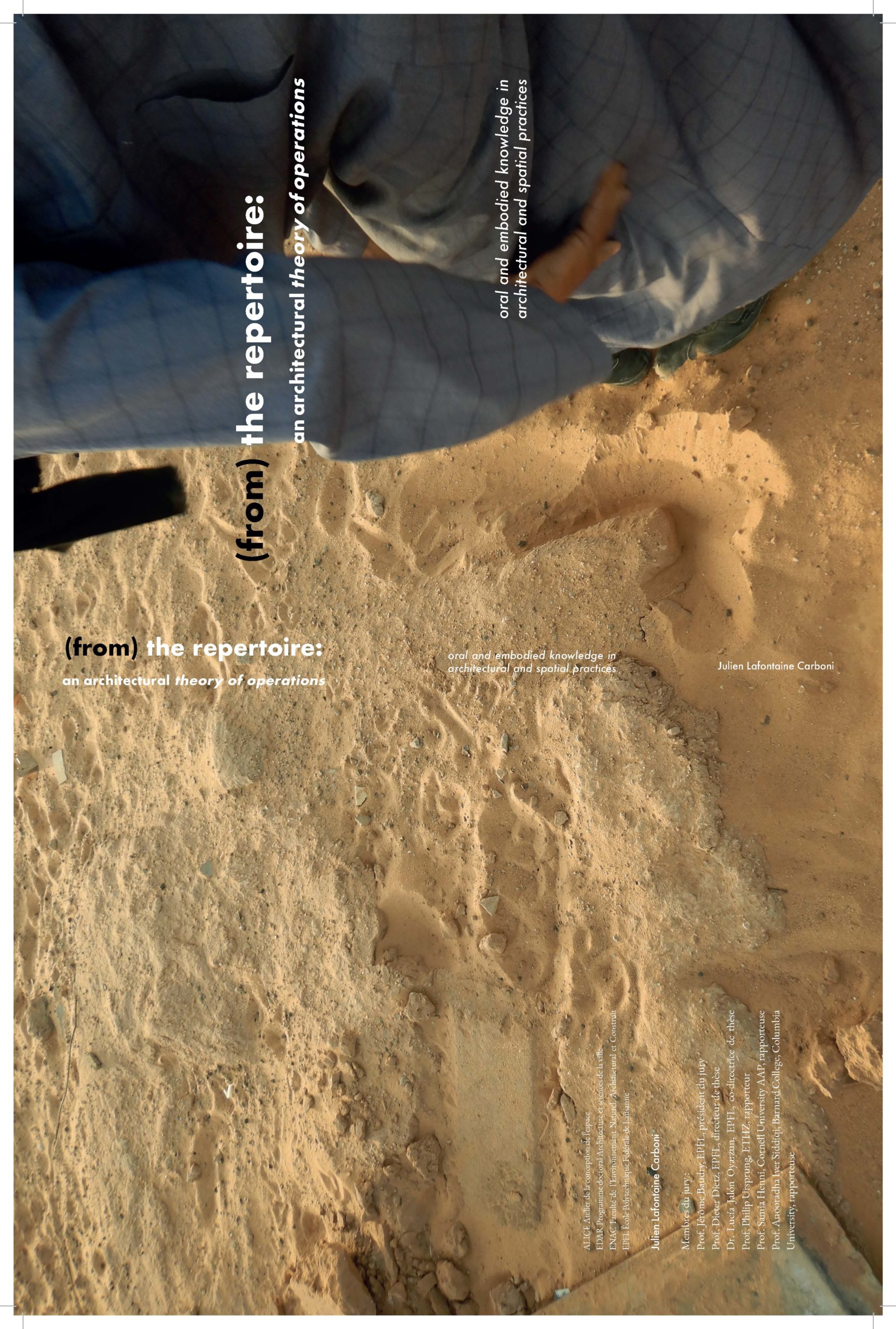seminar
ALICESeminar_info
ALICE’s Research Seminar, Resonances, 15th June 2023, 14.00-18.00, Studio2, Lausanne. With a performance workshop proposed by Jo Baan (https://josephinebaan.com/), a lecture of Mathilde Chénin (http://www.mathildechenin.org/) and a moderated discussion curated by Tiphaine Abenia and Julien Lafontaine Carboni.
ALICESEMINAR_image
ALICESeminar_text
What does it mean to get attuned with a place? What forms of intimacies and care does it unravel?
If resonance is defined as a specific vibratory quality, as an echo of attachment between a space and its inhabitants, what are the textures of these vibratory qualities? To which extent can collective practices become levers of re-attunement? What are the roles of building in these processes?
This ALICE’s Research seminar Resonances will explore affective dimensions of spaces and landscapes to understand how attunement processes are essential practices to navigate in contemporary uncertainties and discrepancies. We propose to give specific attention to how these resonances are produced through commonings and everyday habits and what traces they leave within our milieu and us. Through a lecture from Mathilde Chenin, a performance proposed by Jo Baan and discussions, we will address the micropolitics of vibratory qualities and the ways in which tracing, drawing, and building participate in strengthening vibratory solidarities with our milieus and beyond.
Keywords : Vibrative qualities, attunement, script, collective practices, singularities
Shifting Singularities. Performance Workshop by Joseph Baan.
In this performance workshop we will investigate how to compose the common in singularity. In this case, singularity is understood as the self, with all the ambiguous, disorganized, messy, and sometimes contradicting parts that make up the self. At the heart of this investigation lies how to navigate singularity within groupness, and how to find resonances in decentral, perhaps even conflictual encounters. Ambiguous, conflicting moments and presences constantly occur within the self and in relation. Rather than looking for common ground, we will treat such conflicting moments as a place where resonance can emerge. Through a series of scores and movement exercises, we will consider what it means to affect and to be affected; what it means to inconvenience and to be inconvenienced; and how the self might shift in relation. Please wear comfortable clothes that allow you to move freely.
Presence, resonance, somatic. Vibratory qualities of commonality in the plura. Lecture by Mathilde Chenin.
The presentation will look back at the investigations I carried out during my doctoral research with two artists’ collectives (La Déviation, in Marseille, and Bermuda, in Sergy), one of whose distinctive features is that they spend most of their time materially fabricating their shared living and working space. In this respect, we will focus on the one hand on their gestures: how do they build those places, even though they’re not carpenters, plasterers, electricians, tilers, etc., and what can we learn from the heterodox and idiosyncratic way they use the construction techniques? On the other hand, we will unpack the ordeals and tribulations associated with this commitment to the collective construction effort: how do the groups cope with the disputes that emerge, and how do they continue to hold together? Equipped with the epistemological tools of pragmatic sociology, we’ll be looking at how making together, because it brings bodies not only into presence, but literally into resonance, opens the field to a regime of engagement in action that is, strictly speaking, somatic, defeating usual and liberal types of resolutions, and giving way to the composition of a commonality based on the vibratory qualities of co-presence.
lecture
Corporealities_info
Lecture “Architectural Corporealities. Historiographies, historical crafts and futurities after the nation state” within the seminar series Dissident Domesticities/Diasporic Modernities organized by Dr. Hollyamber Kennedy at ETHZ, D-Arch. 2nd February 2023.
Corporealities_text
This lecture retraces a discussion with Gurba M.L. and Lahsen S.S.B in the Sahrawi refugee camps. It introduces nomadic architectural knowledge’s crafts and transmissions, pointing out how they are shaped by arid ecologies and shape them in return. The term repertoire introduces another infrastructure of re-membrance than the archives, in which performance accesses histories. Gurba’s corpo-realities introduce physics, logics, and grammars of re-membrance and remainders in the repertoire. They draw ways to reduce the distance with what has happened and what is happening outside of the judiciary and nation-state paradigm, while war is ongoing, refugees displaced, and plentiful deserts plundered.
booklaunch
UTBooklaunch_info
Unearthing Traces booklaunch, 22nd February 2023, 17.00, ETH Hönggerberg, Zürich. With Nolan Oswald Dennis, Mariam Issoufou Kamara and Hollyamber Kennedy. Moderated with Nitin Bathla and Denise Bertschi.
UTBooklaunch_text
„UNEARTHING TRACES. Dismantling imperialist entanglements of archives, landscapes and the built environment“, which lives from a wide range of contributors from a transdisciplinary background between architecture, history, art and post-/decolonial studies. It was carefully designed by Melina Wilson & Martin Stoecklin (@_a_language_ ).
„Archival power, silences, and absences profoundly shape and structure postcolonial landscapes, spaces, and urban environments by controlling bodies, histories, and interactions. This book explores pathways to dismantle these imperial
entanglements by developing methodologies and plural epistemologies through an interdisciplinary dialogue between the fields of history, memory politics, critical theory, and archival practice together with the fields of the built environment, landscape, urban studies, architecture, and the arts. Unearthing traces catalyzes critical discussions that not only challenge the objectivity and dismantle the neutrality surrounding current archival practices and archival institutions, but also questions what constitutes as the archive itself. The book unearths potential histories and minor narratives buried by the imperial production of pasts and silences. The diverse range of contributions in the book offer original research,
discussions, positions, and tools and provides a critical resource for scholars, architects, artists, activists, and archivists who want to engage with landscapes and built environments in a critical and postcolonial perspective in relation to archival materials and practices.“ (The editors: Denise Bertschi, Julien Lafontaine Carboni, Nitin Bathla)
Contributors:
Denise Bertschi
Nolan Oswald Dennis @data_body
Abdessamad El Montassir and Julien Lafontaine Carboni @abdessamadelmontassir @jllfcb
Rohit Jain
Hollyamber Kennedy
Léopold Lambert @leopold_lambert_
Françoise Vergès @francoise_verges_decoloniale
Anna Karla de Almeida Santos @annakarlaalmeida
Lena Stina Andersson
Mari Bastashevski @maribastashevski
Jasmine Benhaida
Mathilde Chénin
VOLUMES and Decolonize Zurich @volumeszurich@decolonizezurich
Fares Damien @faresdamien
Atiya Hussain and Stéphanie Savio @stephanie_savio_
George Jepson and Lukas Pauer @nosoeg @thevglthinktank
Sila Karatas @rus.in.urbe
Nagy Makhlouf @power.and.space
Estefanía Mompean Botias @estefaniamompean
Rebecca J. Squires @squiresgrandtour
Safiya El Ghmari and Tafrata Bouchra @sinbad.epub
Lea Marie Nienhoff
Alina Volynskaya
Marlene Wagner @mw_marlenewagner
seminar
ALICESeminar_info
ALICE’s Research Seminar, Dissonant Geometries, 16th November 2022, 12.30-17.00, Arsenic, Lausanne. With a performance proposed by Simon Henein, a lecture of Auxiliadora Galvez and an open round table, curated by Tiphaine Abenia and Julien Lafontaine Carboni.
ALICESEMINAR_image

ALICESeminar_text
This seminar proposed an exploration of dissonant geometries thanks to the intervention of two researcher, and through two mediums: a dance improvisation workshop and a lecture, followed by a round table. The dance workshop was led by Simon Henein, prof. of Mechanical Engineering and creator of the pedagogical experimentation “Improgineering”, and Maria Auxiliadora Galvez, architect, performer and professor at the Institute of Technology of San Pablo.
The dance improvisation workshop explores the spectrum of body motion on stage, from movement to gesture. In dance, movement is generally seen as the displacement of the body segments through space; it is essentially a geometric and kinematic phenomenon. Gesture goes beyond: it is considered to be movement aiming at expressing (semiotic gestures), executing (ergotic gestures) or perceiving (epistemic gestures) something. Since both movement and gesture emanate from the body, the latter can be seen as the place where geometry meets meaning, emotion, action, etc. As Antonin Artaud puts it: “The important thing is to become aware of the localization of emotive thought. One means of recognition is effort or tension; and the same points which support physical effort are those which also support the emanation of emotive thought: they serve as a springboard for the emanation of a feeling.”*. Exploring these concepts through collective improvisation within performative settings reveals them to the eye and constitutes a step towards embodying them.* A. Artaud (1938), Le théâtre et son double. (The Theater and Its Double, Grove Press, 1958, p. 138)
The lecture explores dissident movements of bodies. They are often interpreted as animal ones. When this happens bodies are more prone to be dismissed and marginalized. This lecture used these eccentric movements and positions as places for somatic discoveries. Places of knowledge about ecologies of intimacy in the More Than-Human-World. Rising from this awareness dissident geometries emerge for architecture. Geometries of desire in between materials, living organisms and meteorologies. A Somatic Architecture where bodies are their environments.
roundtable
DCDVRoundtable_info
Roundtable around the exhibition “Des corps dans la ville.”, with Anna Kern, Anne Labroille and Julien Lafontaine Carboni, moderated by Paule Perron, 9th November 2022, at MAIDF, Paris.
DCDVRoundtable_image

DCDVRoundtable_text
Several feminist movements have identified and documented this: the city and architecture, up to now mostly shaped by men for men, produce spaces that are more difficult to appropriate and inhabit by all people. This inequity in relation to space helps to reinforce existing gender discrimination. The right to the city is differentiated and restricted for a variety of the population.
The exhibition Bodies in the City: Architectures, Feminisms and Constructed Spaces attempts to show that a feminist approach to space, in its working methodology as well as in its conception and realization, can participate in initiating a bifurcation towards places that are more open to the appropriation of bodies in their diversity.
conference
DCDNConference_info
“Des corps dans la nuit. Gender Dynamics, normative transgressions, solidarities, and self-defenses,” with Paule Perron at the International Conference on Night Studies, Lisboa, 5th, 6th, 7th October 2022.
DCDNConference_text
This presentation introduces the workshop entitled “Des corps dans la nuit”, which gathered students of the HEAD-Geneva and EPFL to reflect on the materiality of nocturnal spaces and how they participate in the perpetuation of the capitalist and patriarchal domination matrix.
Profusely fantasized and represented as time-spaces of all dangers, insecurities and risk-taking at the charge of the victims, the nights of Western cities produce a polarization of bodies and spaces, regarding their gendered characteristics. Gender, understood as “a particular form of social positioning of bodies experienced in interaction with each other within historically and socially determined institutions and processes that have material effects on the environment in which people act and reproduce power relations and privileges among themselves” (Young 2002), underlines the central role of spatial experience in both the social construction of gender, and the discriminations it produces, that night highlights.
During the five-day workshop nocturnal spaces were claimed and invested as possible territories to subvert, disturb, and thwart the patriarchal norms. The transformation of the inhabiting bodies’ environment, the architectural action, opened up the possibility of subversions through the lived experience of space. We explored spatialized and spatializing subjectivities through the translation of a scene from a movie into a chosen site in Geneva and outlined how night spaces support normative violences. This exploratory methodology allowed us to analyze the intersection of time, space and social situations, considering the bodies, socializations and subjectivities that inhabit the night world.
In this presentation, we will discuss the questions that emerged during the workshop: for whom do we draw? for what situations? What do we (re)produce by doing so? Can we performatively turn patriarchal reproduction on its head? If the worlds and our perceptions of them are constructed and unjust, then can we defend ourselves?
First photography: Nour Keller (EPFL), Valentine Robin (HEAD Bijoux), Ilona Roux (HEAD Mode), Meryem Saffi (HEAD EPFL) & Fanny Tauxe (HEAD AI). Photography by Morgan Carlier HEAD.
Second photography: Mélissa Steenman, Louise Chappuis (EPFL) & Noa Sbaï. Photography by Morgan Carlier HEAD.
lecture
Defense_text
This research delves into oral and embodied architectural and spatial knowledge as modes of producing buildings, spaces and spatialities. This knowledge is transmitted body-to-body through the temporalities of performance, its acts of remaining and means of reappearance, and relies on the repertoire as an infrastructure of transmission and conservation, an organic counterpart to the archives.
(from) the repertoire introduces an architectural theory of operations, opening up the potentialities of oral and embodied modes of architectural production. Epistemological thresholds enable to make contact with the repertoire’s forms of imagination and invention, transmission and migration, historical regimes and potential histories, remainders and agencies. Architectural historiography and image are renegotiated in order to consider the ontology of operations, gestures and words.
The lecture introduces the ambiguities, paradoxes and ethics to work with the repertoire from within the architectural discipline, while introducing elements of the research within the oral memory preservation project in the Sahrawi refugee camps. The lecture draws conclusion on the potential pedagogies, epistemologies and archival practices that could potentially create zones of peaceful reconciliation between the architectural discipline and the repertoire as a proper infrastructure of knowledge production.
conference
Prendresoin_info
“Land of thousand dances, imagination and pedagogies of maintenance labor”, with Camille Fauvel, colloquium Architecture/Philosophie Prendre Soin par l’Architecture et le paysage, of the Philau Network, 9th December 2021.
Prendresoin_text
Caring is a reproductive work (Federici, 2014), of maintenance, of upkeep, of reproduction of the existing. The lexical field of the reproductive -verbs preceded by the prefix -re- indicates a priori an absence of imaginary and inventive act. However, by starting from these numerous bodies (human, non-human, architectural) and their uses, reproduction opens the field of possibilities, and makes room for their previously vulnerable existences.
From a shelter for teenagers who smoke weed when it rains to a play structure for children when the weather is good, the reproductive and programless project allows what (is) happening (time, people and the destruction of worlds by extractivist capitalism) to be the very space of invention, from marginality to room for maneuver. Leaving room for the futurities of the already-there and the uncertainties that characterize it, following the flow of materials and bodies to work with these inventive forces (Ingold, 2010), so many practices that allow us to consider reproduction as a transformative horizon (Haraway, 2016). In this paper, we wish to explore the inventive potential of care and reproductive work in architecture by interrogating it in the context of a pedagogical experiment.
To study and transmit the practice of this notion, we set up a transdisciplinary course within ENAC, EPFL. Intensive format over a full week, this workshop is part of a compulsory elective course and is aimed at 2nd year undergraduate students in architecture, civil engineering and environmental science. It brings together students who have already studied the subject for a year and who are at least interested in it.
Drawing and photograph done by the participants to the course, see Teaching.
conference
UTConf_info
“Unearthing Traces. Dismantling the imperialist entanglements of archives and the built environment.” International Conference and Doctoral Course organized by Denise Bertschi and Julien Lafontaine Carboni, with the support of Lucia Jalon Oyarzun, Stéphanie Ginalski, and Yves Pedrazzini. 28th, 29th, 30th May 2021.
UTConf_text
Engaging with the local context of Neuchâtel as one of the most implicated Swiss cities in a “colonial Switzerland without colonies” (Purtschert 2012), we aim to rehearse (Azoulay, 2019) a set of methodologies in tracing architectural structures and spacial situations regarding their material histories and political/economical existences. Switzerland was considered for a long time to be uninvolved in colonialism, supported by the narrative of its “neutral” role in world politics. Newer research has proved otherwise: The Swiss entanglement in a colonial world system as a quasi-imperialist power (Fischer-Tiné 2015) was marked by its strong interconnectedness through a Swiss economic expansion in a global trade system based on capitalist agriculture, land expropriation and deforestation or transit-trade with colonial goods as coffee, textiles or precious stones. Its surplus flowed back into the Swiss system, its built cities and institutions. To investigate these material witnesses (Schuppli 2020) of such historical connectedness, we will visit in Neuchâtel the following sites: the Villa of the Museum of Ethnography (MEN), the Hospital of Préfargier, the Place de Pury, the Espace Tilo Frey (formerly Espace Louis-Agassiz), and others.
The conference and doctoral course are continued through a publication which explores the politics of memory at the intersection of archives and the built environment bringing in a wide array of perspectives, methods and practices to unearth and dismantle traces of colonialism and coloniality within European urban environments. The conference gathered international scholars and artists, such as Françoise Vergès, Léopold Lambert, Rohit Jain, Nolan Oswald Dennis, Shourideh Molavi, Samia Henni, Hollyamber Kennedy, Michelle Caswell, Jovita dos Santos Pinto, Faustin Linyekula, Abdessamad El Montassir and Doreen Mende to whom we are grateful for their generosity and implication in the project.
Photography by Denise Bertschi.
conference
DeepCity_info
“Deep City. Climate Crisis, Democracy and the Digital” International Conference organized by ALICE laboratory and LDM (prof. Dieter Dietz and prof. Jeffrey Huang), with the support of the Latsis Foundation. 24th, 25th, 36th March 2021.
DeepCity_text
Politicians, social scientists, urbanists, and architects find their working methods and disciplinary knowledge challenged by insights derived from big data, machine learning and Artificial Intelligence (A.I.). As both citizens and experts in the many respective fields, our mission must be to bring in our disciplinary knowledge and civic engagement to support the appropriate development and discussion of data-driven tools, to consider both their biases and potentials, and to promote broader social literacy and criticality. Ultimately, it is a question of both decanting the technical quality of these new instruments of design, management and decision making, as well as enhancing democratic control over them. How do we do this? Do our disciplines currently lack adequate strategies to understand, let alone critique or exploit the knowledge-products of machine learning, artificial intelligence and big data?
During this conference, I participated in the scientific committee, worked on the scenography (digital+physical), chaired a paper session (on New material agencies), and moderated Shanon Mattern’s Keynote lecture.
seminar
SBFOVI_info
“Haunted bodies and ghostly spatialities”, with Gabriele Schwab and Avery Gordon, as part of the seminar series “Surrounded by a Fog of Virtual Images”, 20th January 2021.
SBFOVI_image

SBFOVI_text
Ghosts and hauntings are familiar with architecture. Das Unheimliche, the essay of Freud, resonated all along the XXth century into architectural theory. Unhomeliness has been first thought of as a bourgeois aesthetic experience referring to estranged homes to their inhabitants and leading to the haunted house’s figure. Secondly, the development of psychoanalysis in architectural methods and theories to address the fundamental unlivable conditions of the modern city shifted the relations between bodies and architecture, site and structure, and paved the way to deconstructivism’s dismembered bodies and below language aesthetics.
However, a third way remains unaddressed in the architectural field. Ghosts appear asking for reparations. Traces of institutionalized violence and silencing, their phenomenal existence is an effective, shared, and lived reality. As a particular figure of plural temporalities defining affective landscapes, ghosts inhabit, dwell, and thus, shape and influence our spatialities. Not our past, our commons, ghosts are a particular texture of living memories with whom we are sharing our lands, practices, and becoming.
For this second session of the seminar Surrounded by a fog of virtual images, we aim at addressing architectural histories of haunting, as much as the spatial dimensions and agencies of ghosts. Starting from different perspectives (sociology, architectural, and critical theory), this discussion aims at opening common grounds for critical, intersectional, and reparative architectural (hi)stories.
We will do it in collaboration with Avery Gordon, whose intervention will address subversive historical alternatives, with the aim of returning to the ghost a certain agency with which the living might make common cause. Meanwhile, Gabriele Schwab will ask how “ghostly spatialities” affect the texture of traumatic memories. Under the title “Memory Crypts”, she will use several examples from her hometown in order to analyze these haunting memories, including the erasure of traces of Jewish life, a spatial memory of Roma life, and a memory of the discovery of an Aleman burial ground.
conference
OUISO20_info
“Immobile Nomadism. Architectural knowledge and minor histories of the Sahrawi refugee camps from 1975 to 1991.” Journées d’études sur le Sahara Occidental, organized by the OUISO (Observatoire Universitaire International sur le Sahara Occidental), 12th November 2020.
OUISO20_text
Entering the archives of the SADR Ministry of Information, I was impressed by the amount of documents available; along a corridor, in small rooms closed to the outside, thousands of films, newspapers, books… Todo lo que desee aprender sobre la historia saharaui, lo encontrará aquí’ says Lahsen Selki Sidi Buna, my host/guide/collaborator/translator/friend.
However, as we were working on the memory and history of the Saharawi refugee camps from 1975 to 1991 from an architectural and territorial perspective, when women were alone in building the camps and the state, this background was extremely difficult to interpret. No plan, no drawing, no legend accompanied these thousands of documents. On the ground of the many camps that were inhabited and then abandoned, there are also very few traces of the years of life and refuge, the wind, the rains and the heat having erased everything.
On the other hand, when Mohamed Ali Laman inserts his hard disk in the computer of his office in the Saharawi Ministry of Culture, a storm of memories and knowledge surges through the speakers.
This presentation narrates the visits to the archives of the SADR in Rabuni and the discussion with Lahsen Selki Sidi Buna and several aging woman who built the refugee camps. It argues that the materialities and temporalities through which architectural knowledge are transmitted and architectural histories produced demands a profound change in the archival politics that are yet applied in the refugee camps for new generations to inherit the oral and embodied knowledge of former generations.





















